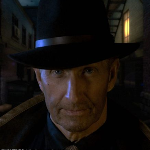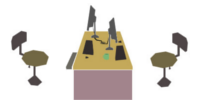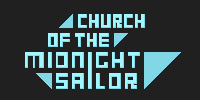Interview: The Poisoned Pawn’s Mat Van Rhoon
Developed by independent collective Chaotic Fusion in association with Big Finish Games, The Poisoned Pawn – A Tex Murphy Adventure combines film noir with dystopian sci fi, and as the team (Mat Van Rhoon – Producer/Game design, Holger Kreetz – Design Lead, Darren Sebire – Programming and Integrations Lead, Karen Corthouts – 3D / 2D design and art) spins yarns in the ashes of World War III, I asked Mat to pull back the curtain a bit, and we chatted on the goals and mindsets behind the project.
Erik Meyer: The Poisoned Pawn inherits from a rich franchise as it takes up the Tex Murphy mantle, so what kinds of pressures and challenges come from working with a series that has existed for nearly 20 years?
Mat Van Rhoon: We feel we’ve been given a tremendous opportunity to carry on the Tex Murphy franchise, while at the same time we feel extremely humbled by the original creators’ trust in our ability to deliver. It’s a great responsibility. All of us are long-time fans of the series, which has helped a lot. I don’t think there is a single aspect of any existing Tex Murphy title that our team doesn’t have intimidate knowledge about. The connection we have with Chris and Aaron has helped solidify this knowledge.
In addition to what we already know about the series, working closely with Aaron (who is writing all-new content for us) has been a wonderful experience, and helped us to ensure that this new installment addresses one of our primary concerns: will the new game feel like a Tex Murphy title? We are confident that our partnership will meet this expectation.
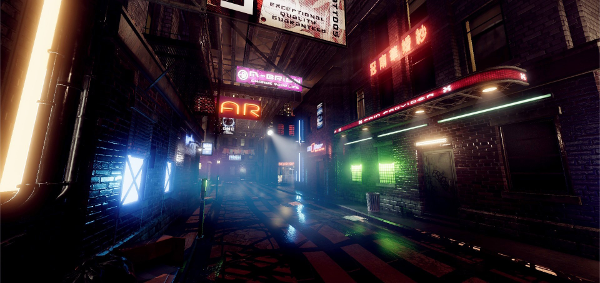
EM: Your trailer provides a variety of in-game visuals to set the 2050s detective noir tone, so as you’ve created locations and assets, what have you used as your guide? What translates to both gumshoe and 2050?
MVR: Because the game originally began as a re-telling of the Overseer story, the locations that were part of that title were the inspiration for many of the locations in The Poisoned Pawn. However, we have taken a few liberties to help continue bringing New San Francisco to life. Holger (our lead level designer) has done a fantastic job combining the traditional Noir-like elements with a more modern cyberpunk style.
We feel that these enhancements aren’t so much a result of the evolution of the locations themselves, but the evolution of the technology employed in creating them. And these days, we are able to achieve a lot more than what was possible back in the 90s.
EM: Over the last 40 years, cyberpunk elements have found their way into scores of books, movies, and games, such that each universe has to define the particular kinds of cybernetics, software, and intrigue that dominate the populace. As developers, do you maintain a timeline of technologies and historical events? Is the game the tip of the iceberg, and when it comes to a need to maintain consistency (of tone, technology, history), what does that look like on your end?
MVR: One of the most challenging parts of creating a believable futuristic environment is envisioning what kind of technology the human race would utilize or take for granted. Take something as simple as a cell phone – to us, it’s a common technology we take for granted… but 40 years ago, it would’ve seemed like complete science fiction and beyond the realms of possibility. When stepping 40 years into the future, we not only need to imagine what new technology people will be using, but how they will be using it (or taking it for granted).
We also need to consider that sometimes too much fantastic technology can be distracting. We want players to think “wow, this looks cool” then quickly become accustomed to it, so it simply is an integral part of their surroundings.
As for a timeline of events… the Tex Murphy series is post-apocalyptic (after World War III) so we already have an idea of the chronology of events that lead us to where we are in 2050. While many of the cities in the US lay in ruins, massive cities were built among the devastated environments, and maintained in a way that they “sparkle like a chunk of cubic zirconium”. It’s almost as if the new cities were built to help forget the past, or rather: ignore it.
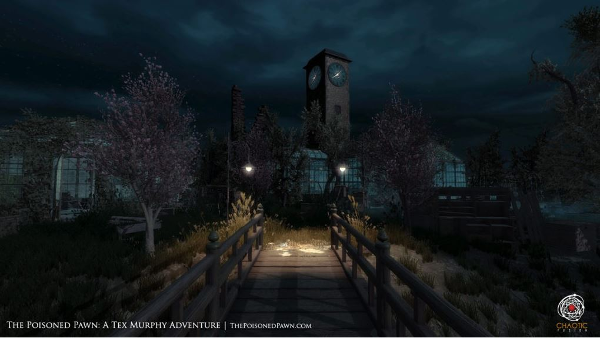
EM: Chaotic Fusion is constituted by four people (yourself included), but you also have the connection to Big Finish Games, so I’m interested in your creative process and how the different elements of your work come together. When you work on things like narrative, how do you then plot out asset creation and pipeline? What does development communication look like, and as you release info to an eager audience, what do you do to help set expectations?
MVR: The Chaotic Fusion team has been developing this title for almost 3 years. Originally, Big Finish Games only sanctioned its development (when it was only an Overseer remake). However, shortly after I came on board, I acted a liaison between CF and BFG to help provide a greater connection between the two entities. The game had evolved so much that it made sense to turn it into something greater than just a remake.
The four members of Chaotic Fusion share a lot of enthusiasm when it comes to developing this game. We’re always discussing ways in which we can improve and add to it both environmentally and technologically. It’s really quite a well-oiled machine of creatively inspired folks. In addition to this, Aaron is writing dialogue, story and continuity which we integrate into our environments and gameplay. Each step of the way comes with an in-depth discussion to ensure there is no disconnection with all the elements. We go through a lot of iterations, and each new idea (either environmentally or story-wise) is discussed and refined. We know that if we can all be happy with the outcome, fans will be happy too.
EM: On the site, the game is described as, ‘…an independent title with Triple A dedication.’ I note inclusions like VR support and high-end graphics, but I also note that over the last few years, the line between many indie games and Triple A games has blurred a bit. Game engines have taken great steps ahead, as has other software. Additionally, a generation has grown up with a passion for gaming. As a studio, from a technical standpoint (bug-free release, consistently high frame rate, seamless cutscenes, etc), what kinds of things do you associate with polished, professional games?
MVR: I have actually avoided using the term “Triple A” as much as I can because I also agree that the line has blurred between that and Indie. And to be brutally honest: I think Indie is in a much better place right now. “Triple A” used to indicate quality, but recent developments within the Triple A industry have shifted this view more pessimistically. Right now, a lot of it is about money and sales.
Gamers and players are smart people… they can smell a cash-grab from a mile away, and no amount of stellar graphics will change that. So a lot of Indie developers have been taking the positive aspects of the previously defined “Triple A” industry such as graphics and technology, and wrapping them up with an independent small-team methodology. You are correct: with modern gaming engines, and access to some truly amazing development tools, there is no reason why a small (yet dedicated) team can’t deliver something that stands alongside the industry giants.
To us, polish is not just about graphics… it is about the extra 10% on top of an already finished product. It’s the ability to say: “We achieved our goals, so now let’s add a bit more”. It’s listening to our fans and their feedback and doing our best to address their concerns. You can’t please everybody, that’s for certain… but polish is about doing what you can to try.
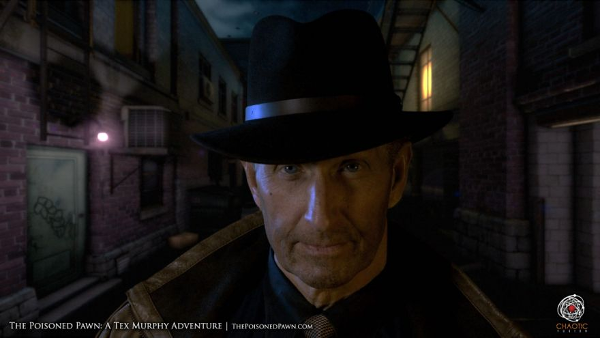
EM: When I was a kid, terms like World War III had a particular feel, given that my grandparents fought in World War II, and the Cold War was still a thing. Since then, the world has gotten… stranger. This isn’t to say the idea of a dehumanizing future has in any way disappeared (Fallout, Beneath a Steel Sky, Deus Ex, Shadowrun), but in the Tex Murphy narrative, what kinds of intrigue and commentary do you see entering the current conversation regarding dysfunctional would-be societies?
MVR: Aaron has always been great at predicting future events, even on the political scale. Thankfully, he was wrong about World War III… so far. But look at Overseer as an example: there was a big focus on the “Law and Order Party”, a quasi-fascist political organization who believes that mutants have no place in modern society. You get where I am going with this.
I cannot speak for Aaron directly on how he manages to tie politics and modern social commentary into his stories. I know that he doesn’t try to be contentious or attempt to deliver his own personal opinions in his writing. He just knows how to write a good story, and it is testament to his talent that so many of the aspects of mankind he has written about fictionally have hit quite close to home in recent years.
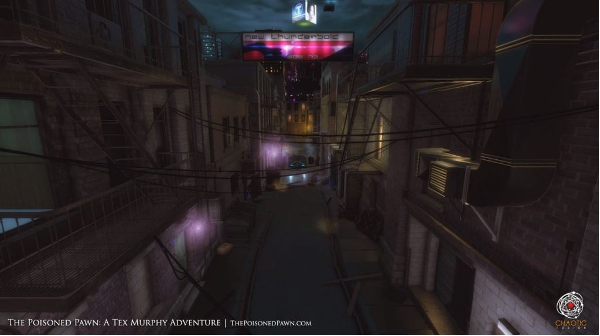
EM: As a team, what constitutes most of your time, at this point, and as you look to the horizon, what larger benchmarks/hurdles loom in the distance? From an implementation standpoint, what elements have come together as planned, and where have you had to reimagine your initial vision?
MVR: At the moment, we have completed most of our locations that will be used throughout the Poisoned Pawn Story. We recently transitioned over to the newest version of Unity (2017) which has taken a good chunk of time, but it will be totally worth it from a technological standpoint.
Now we have begun piecing together the events that take place in the games’ story chronologically, and exploring the best way to present this story in terms of gameplay mechanic. Sometimes we reassess an approach if it’s not working as planned. As mentioned earlier, our team loves to come up with new ideas, and we inspire each-other to do so. So we will try new things, and sometimes they work, sometimes they don’t.
There is, of course, the constant pressure of a looming deadline. We currently don’t have any hard deadline other than what we promised to fans, but we feel obligated to do our best to meet these promises. But we also constantly straddle the line between “do we delay it a bit to add in more really cool stuff that we want to, or do we suggest a cut-off point to meet a more strict deadline”. Not having a publisher or distributor in place enables this decision to be ours, which is at least a strong positive.
In case you missed it, here’s the trailer:
https://www.youtube.com/watch?v=qLwljxGF1yU

